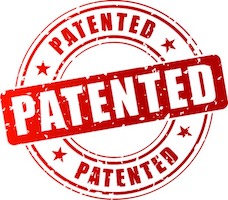“For purposes of section 287(a), notice must be of ‘the infringement,’ not merely notice of the patent’s existence or ownership.” – CAFC
 The U.S. Court of Appeals for the Federal Circuit (CAFC), in a precedential opinion authored by Judge Dyk, partially reversed a ruling by the U.S. District Court for the Central District of California that had awarded damages to Lubby Holdings LLC for patent infringement by Henry Chung. While the Federal Circuit agreed that Chung directly infringed, it held that the court erred in awarding damages for the sales of infringing products prior to commencement of the case, which represents the date Chung received actual notice of the ’284 patent under the patent marking requirement of 35 U.S.C. § 287. Judge Newman concurred in part and dissented in part.
The U.S. Court of Appeals for the Federal Circuit (CAFC), in a precedential opinion authored by Judge Dyk, partially reversed a ruling by the U.S. District Court for the Central District of California that had awarded damages to Lubby Holdings LLC for patent infringement by Henry Chung. While the Federal Circuit agreed that Chung directly infringed, it held that the court erred in awarding damages for the sales of infringing products prior to commencement of the case, which represents the date Chung received actual notice of the ’284 patent under the patent marking requirement of 35 U.S.C. § 287. Judge Newman concurred in part and dissented in part.
Lubby Holdings’ U.S. Patent No. 9,750,284 is for a “Personal Vaporizer.” The ‘284 patent specifically covers vaporizers that resist leaking. In 2018, Lubby sued Chung for infringement, and after a three-day trial, a jury found Chung liable for direct infringement and awarded Lubby $863,963.10 in damages. Chung moved for judgment as a matter of law (JMOL) under Rule 50(b) and a new trial under Rule 59(a), arguing that the verdict of liability was against the clear weight of the evidence, but the court denied these motions.
Under Rule 59(a), the Federal Circuit reviewed Chung’s claim that there was no evidence in the trial record to support the jury’s verdict of direct infringement according to an “abuse of discretion” standard of review, which requires the court to reverse the jury’s finding of infringement “only where there is an absolute absence of evidence to support the jury’s verdict.” The CAFC said there was evidence to support the jury’s verdict, including Chung’s own testimony that he designed the accused products, that he sold the products through his company, and that he made the decision to sell the products through his company. Although Chung argued that he could not be held liable for infringement based on acts he carried out on behalf of his company, the CAFC said that “officers can be personally liable for their own acts of infringement, even if those acts were committed in their corporate capacity.” The court added:
Given the evidence that Mr. Chung sold the allegedly infringing products and the deferential standard of review, we must uphold the jury’s verdict that Mr. Chung is personally liable for direct infringement of the ’284 patent.
Notice Under Marking Statute
Turning to Chung’s argument that Lubby failed to comply with the patent marking requirement under 35 U.S.C. § 287, the CAFC said that Chung met his burden of production as an accused infringer to “put the patentee on notice that he or his authorized licensees sold specific unmarked products which the alleged infringer believes practice the patent.” Lubby, on the other hand, did not meet its burden to prove that the product identified by Chung as unmarked “did not practice the patent or that it marked the products it actually sold and thus failed to establish that it marked the products as required by § 287.” Thus, the court said that Lubby “can recover damages only for the period that it provided actual notice to Mr. Chung.”
While Lubby argued that Chung had notice as of the issuance of the patent, the court explained that “[f]or purposes of section 287(a), notice must be of ‘the infringement,’ not merely notice of the patent’s existence or ownership.” Lubby’s cited evidence and testimony to the contrary “do not show that Lubby…provided Mr. Chung ‘[an] affirmative communication of a specific charge of infringement by a specific accused product or device.” Thus, said the court, damages can only be awarded for infringing units sold
after the filing of the lawsuit. The CAFC ultimately affirmed the district court’s denial of Chung’s Rule 59(a) motion on direct infringement but reversed the denial of his Rule 50(b) motion for the units sold prior to the filing of Lubby’s complaint, remanding for a new trial “to determine the number of sales made by Mr. Chung following the filing of the complaint and the amount of a reasonable royalty associated for these units.”
Newman Dissent
Judge Pauline Newman agreed with the court that Chung directly infringed, but said that the jury verdict on damages was supported by substantial evidence and that the CAFC had no “sound basis” to discard it. Newman said the majority’s analysis ignored Chung’s “admitted knowledge” and overstepped the appellate court’s role, which is not to “reweigh the evidence.”
Image Source: Deposit Photos
Vector ID:47994353
Copyright:nickylarson

![[IPWatchdog Logo]](https://ipwatchdog.com/wp-content/themes/IPWatchdog%20-%202023/assets/images/temp/logo-small@2x.png)

![[Advertisement]](https://ipwatchdog.com/wp-content/uploads/2024/04/Artificial-Intelligence-2024-REPLAY-sidebar-700x500-1.jpg)
![[Advertisement]](https://ipwatchdog.com/wp-content/uploads/2024/04/Patent-Litigation-Masters-2024-sidebar-700x500-1.jpg)

![[Advertisement]](https://ipwatchdog.com/wp-content/uploads/2021/12/WEBINAR-336-x-280-px.png)
![[Advertisement]](https://ipwatchdog.com/wp-content/uploads/2021/12/2021-Patent-Practice-on-Demand-recorded-Feb-2021-336-x-280.jpg)
![[Advertisement]](https://ipwatchdog.com/wp-content/uploads/2021/12/Ad-4-The-Invent-Patent-System™.png)






Join the Discussion
One comment so far.
Josh Malone
September 3, 2021 07:59 amNotice of a patent with one or more claims particularly pointing out and distinctly claiming the subject matter which the inventor regards as the invention isn’t notice? This is absurd.
Terrible decision. We should get rid of claims. Or get rid of lawyers. They NEVER understand the scope of the invention and they ALWAYS argue about it until the end. Modern U.S. litigation tactics and jurisprudence have made peripheral claiming obsolete.